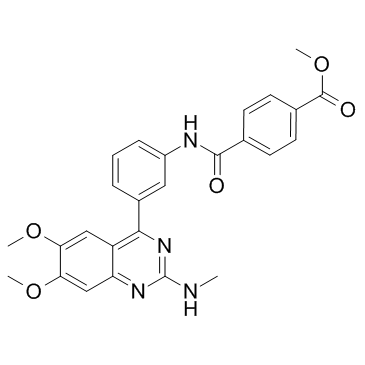947620-48-6
| Name | methyl 4-[[3-[6,7-dimethoxy-2-(methylamino)quinazolin-4-yl]phenyl]carbamoyl]benzoate |
|---|---|
| Synonyms |
unii-to043kkb9c
e6005 RVT-501 |
| Description | Lotamilast is a selective phosphodiesterase 4 (PDE4) inhibitor with an IC50 of 2.8 nM. |
|---|---|
| Related Catalog | |
| Target |
IC50: 2.8 nM (human PDE4)[1] |
| In Vitro | Lotamilast potently and selectively inhibits human PDE4 activity with an IC50 of 2.8 nM and suppresses the production of various cytokines from human lymphocytes and monocytes with IC50 values ranging from 0.49 to 3.1 nM[1]. |
| In Vivo | Lotamilast is currently in phase 2 development for patients with mild-to-moderate atopic dermatitis. In mice models, the topical application of Lotamilast produces an immediate antipruritic effect as well as an anti-inflammatory effect with reduced expression of cytokines/adhesion molecules. On the basis of these observed effects, topical RVT-501 ameliorates the appearance of atopic dermatitis-like skin lesions in two types of AD models, hapten- and mite-elicited models, exhibiting inhibitory effects comparable to that of tacrolimus[1]. A single topical application of Lotamilast significantly inhibits spontaneous scratching during 1–2 h after application in mice with chronic dermatitis; the inhibition is partial and similar between 0.01% and 0.03%. Topical application of 0.03% Lotamilast to the rostral back significantly inhibits the increased activity of the cutaneous nerve in mice with chronic dermatitis. The cutaneous concentration of cAMP is significantly decreased in mice with chronic dermatitis, and this decrease is reversed by topical Lotamilast application[2]. |
| Kinase Assay | PDE isoenzyme activities are quantified by measuring the formation of [3H]5′-AMP or [[3H]5′-GMP from [[3H]cAMP or [[3H]cGMP using an enzyme isolated from bovine brain (for PDE1), differentiated U-937 cells (for PDE2), human platelets (for PDE3 and PDE5), and U-937 cells (for PDE4). The test compounds (RVT-501), reference compounds, or vehicle (water) is added to a reaction buffer. The reaction is initialized by addition of the enzyme, and the mixture is incubated for 60 minutes at 22°C. After incubation, the reaction is stopped by heating the plate to 60°C for 3 minutes, after which time scintillation proximity assay beads are added. After 20 minutes of shaking at 22°C, the amount of [[3H]5′-AMP or [[3H]5′-GMP is quantified with a scintillation counters[1]. |
| Animal Admin | Mice: Lotamilast is applied to the hair-clipped rostral back. Observation of hind-paw scratching and electrophysiological recording of the cutaneous nerve branch are conducted. The effects of topical application of E6005 are evaluated 1 h after application, because topical application of the vehicle elicited hind-paw scratching for 40 min. The cutaneous concentration of cAMP is measured by enzyme immunoassay[2]. |
| References |
| Molecular Formula | C26H24N4O5 |
|---|---|
| Molecular Weight | 472.49300 |
| Exact Mass | 472.17500 |
| PSA | 114.90000 |
| LogP | 3.88950 |
